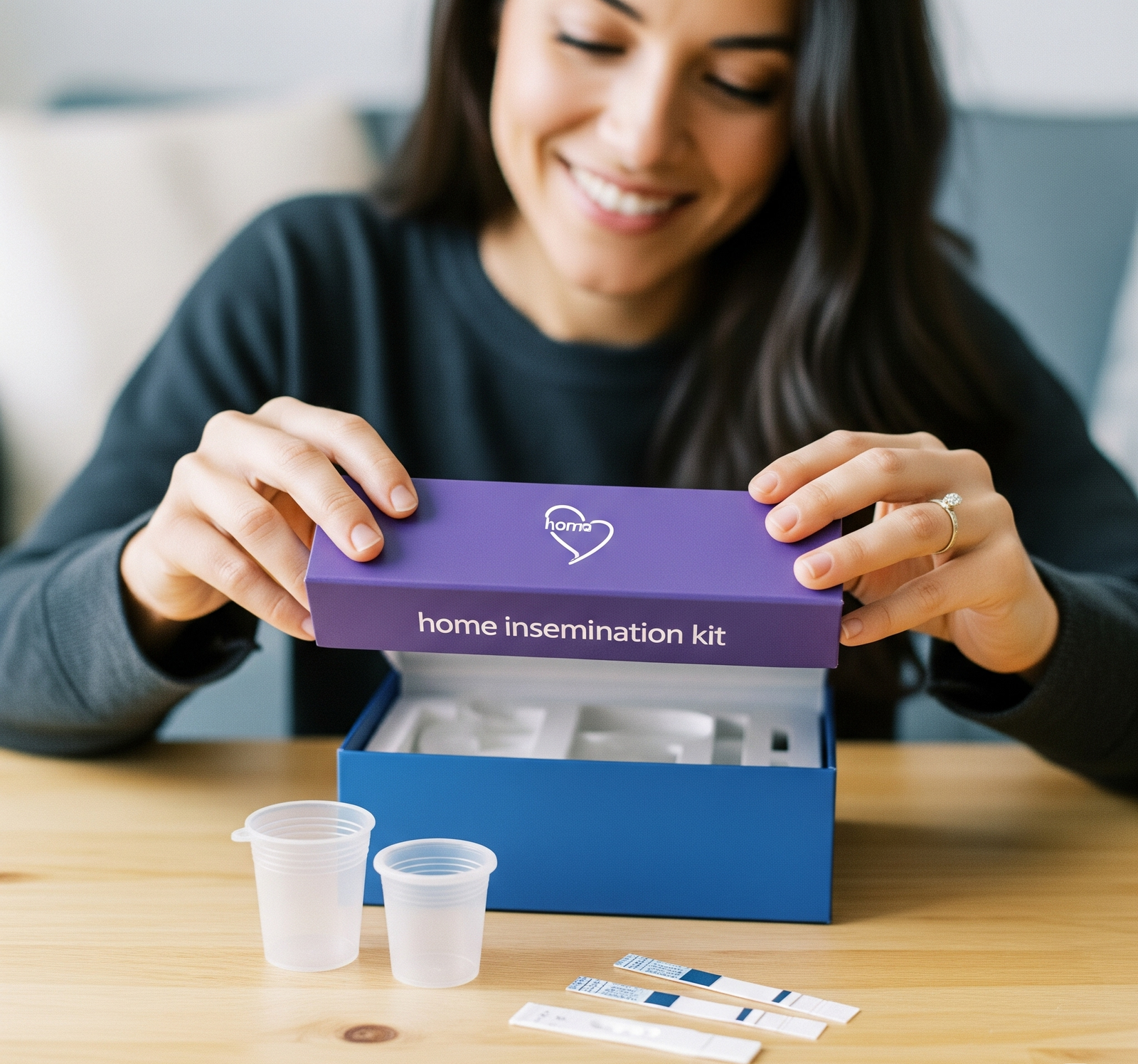Understanding IUI at Home

IUI at home is a path many women choose. It means you are putting donor sperm into your body yourself. This guide will help you understand the process. You will learn about its safety and what you need to be ready.
What is IUI at Home?
IUI at home is simple. It means putting donor sperm into your body at home. You do not go to a clinic. This is different from clinic IUI. Clinic IUI uses medical tools. It happens in a doctor’s office.
Many women choose IUI at home. They like the privacy. It feels more comfortable in their own space. It also costs less money. Clinic visits can be very expensive. Doing it at home gives you more control. You pick your timing. You choose your pace.
So, who uses IUI at home? Single women might choose this path. Lesbian couples often do. Some straight couples use it too. This is if the man has certain issues. This could be problems with erections. It is not for severe male fertility issues. It is also common with a known sperm donor.
What the Studies Say About IUI at Home
 Many people ask, “Does IUI at home really work?” Research shows it can.
Many people ask, “Does IUI at home really work?” Research shows it can.
One study compared women using donor sperm at home versus in a clinic. Both groups did six cycles. At the end, pregnancy rates were almost the same. Thirteen out of 29 women got pregnant at home. Eleven out of 24 got pregnant in the clinic. This shows that home insemination can be just as effective when done right.
Another study looked at couples who could not have sex. This included conditions like vaginismus and erectile problems. They used home insemination. For women aged 20 to 33, the success rate was 69% within six cycles. Even for older women, results were still strong. You can read the study here.
An older report from the British Medical Journal also supports the idea. It showed that home insemination was safe, doable, and well accepted by patients. This helped start the use of at-home insemination in donor programs.
These studies don’t guarantee results. But they show home IUI is not just a guess. It has real potential. With care, timing, and the right supplies, many women have success at home.
Key Study Results on Home Insemination
Below is a summary of key pregnancy rates reported in three PubMed studies on home insemination. Use this visual guide to see how home methods compare across different groups.
| Group | Success Rate (%) |
|---|---|
| Home IUI (6 cycles, thawed donor sperm) | 44.8 |
| Clinic IUI (6 cycles, thawed donor sperm) | 45.8 |
| Couples with unconsummated marriage, Age 20–33 | 69 |
| Couples with unconsummated marriage, Age 33–36 | 43 |
| Couples with unconsummated marriage, Age >36 | 25 |
📊 Bar Chart of Success Rates
Each bar represents the percentage of pregnancies achieved in the respective group.
Is IUI at Home Safe and Effective?

Safety is important for IUI at home. Make sure your tools are clean. Use sterile equipment. Handle sperm very carefully. There is a small risk of infection. This risk is low if you are careful.
The success rates for IUI at home are lower. They are generally less than clinic IUI. Many things affect success. Your age plays a part. The quality of the sperm matters. Timing is very important too. Have real expectations. It may take more than one try.
When should you not do IUI at home? If you have known fertility problems, do not try it. Examples include blocked tubes. Severe ovulation problems also mean it is not for you. Do not use sperm that has not been checked. You need to understand your own cycle well. If not, it is best to see a doctor.
Getting Ready: Your Body and Cycle
You need to know your menstrual cycle. This means knowing when you ovulate. Ovulation is when your egg is released. You can track this with kits. Ovulation prediction kits (OPKs) help. You can also track your basal body temperature (BBT). Check your cervical mucus too. Timing is key for IUI at home. Insemination must happen when you are ovulating.
Get a general health check first. It is good to see a doctor. They can check your basic fertility health. This makes sure your body is ready.
Think about your feelings too. Prepare for this journey. It can be emotional. Try to keep stress low. Manage your hopes. Remember, it is a process. Be kind to yourself.
The Essentials for IUI at Home

For a successful IUI at home experience, having the right tools and knowing how to prepare is key. This part of the guide will walk you through getting sperm, gathering supplies, and preparing for insemination.
Getting Sperm for IUI at Home
You can use a known sperm donor. This is someone you know. Make sure they get full medical checks. They need tests for infections. They also need genetic tests. A legal paper is very important. This paper makes sure the donor gives up parental rights. Know how to carry and store fresh sperm. It needs to stay at the right temperature.
You can also use an anonymous sperm donor. This means using a sperm bank. You will order vials for your IUI at home efforts. Pick the right kind of vial. Some are “IUI-ready.” Others are “ICI-ready.” We will explain these types soon. The sperm bank will ship the vials to you. You must store them properly when they arrive. They need to stay frozen.
Important Supplies

You will need a few key items. An At home insemination kit usually has what you need. These kits often include syringes. They also have cups for sperm. You can buy these kits online. Always make sure they are sterile. This means they are very clean.
Ovulation prediction kits (OPKs) are a must. They help you know when you are ovulating. There are many types. Read the directions carefully. A basal body thermometer (BBT) helps too. It tracks small changes in your body heat.
Other items can be useful. A speculum can help you see better. Sterile gloves keep things clean. Use sperm-friendly lubricant. Regular lube can hurt sperm. Have timers and calendars ready. These help you track everything.
Preparing the Sperm
How you prepare sperm depends on its type.
For fresh sperm from a known donor, collect it safely. Keep it at the right temperature. Fresh sperm needs to be used fast. Time is important here.
For frozen sperm from a sperm bank, you must thaw it. Follow the thawing steps exactly. Do not use heat or a microwave. This can harm the sperm. Once thawed, use the vial quickly. There is a small time window.
Understand IUI-ready versus ICI-ready sperm. IUI-ready sperm is “washed.” This means it can go right into your uterus. ICI-ready sperm is “unwashed.” It has other fluids with it. It is for placing near the cervix. If you want to put ICI-ready sperm into your uterus, it needs washing first. This usually happens in a lab.
The IUI at Home Procedure & Aftercare

Performing IUI at home involves careful steps. This guide provides detailed instructions for the insemination process itself. It also covers what comes after and when seeking medical advice is best.
The Insemination Process
First, get your space ready. Make sure it is clean. It should be a private place. Gather all your supplies. Have everything you need close by.
Position yourself in a good way. Lie down. Lift your hips a little. You can put a pillow under them. Try to relax your muscles. This makes the process easier.
Next, draw up the sperm. Do this slowly. Be gentle. Make sure there are no air bubbles. Air bubbles are not good.
Now, insert the syringe. Guide it toward your cervix. The cervix is the opening to your uterus. Move slowly and steadily. Release the sperm gently. For IUI at home, the sperm usually goes near the cervix. It does not go deep into the uterus. This is unless a medical person helps you.
After putting the sperm in, rest. Lie down for 15 to 30 minutes. This helps the sperm stay inside. You can also use a menstrual cup. Insert a clean menstrual cup after insemination. This holds the sperm close to your cervix. It can make it feel safer to move around. You do not have to stay lying down. Know what to expect right after. You might feel a little wetness. This is normal.
After the Insemination

Track any changes in your body. Look for early signs of pregnancy. Or, watch for your period. Know when to take a pregnancy test. Wait until your period is due.
What if you do not get pregnant? Look back at your steps. Think about what happened. Consider what you will do next. It is okay if it does not work the first time. Think about when to ask a doctor for advice.
Take care of your feelings. Trying to get pregnant can be hard. It can cause stress. Find people who support you. Talk to friends or family.
When to Seek Professional Help
Sometimes, IUI at home is not enough. This might be true after several tries. If you have concerns about your fertility, get help. If you have known medical problems, see a doctor. They can give you proper care.
Talk to a fertility doctor. They can do a full check-up. This is called a fertility workup. They can talk about other options. These include IUI at a clinic. They might also suggest IVF.
Remember legal and ethical points. If you use a known donor, get legal advice. This protects everyone. Also, think about telling your future child about the donor. This is an important talk for later.




